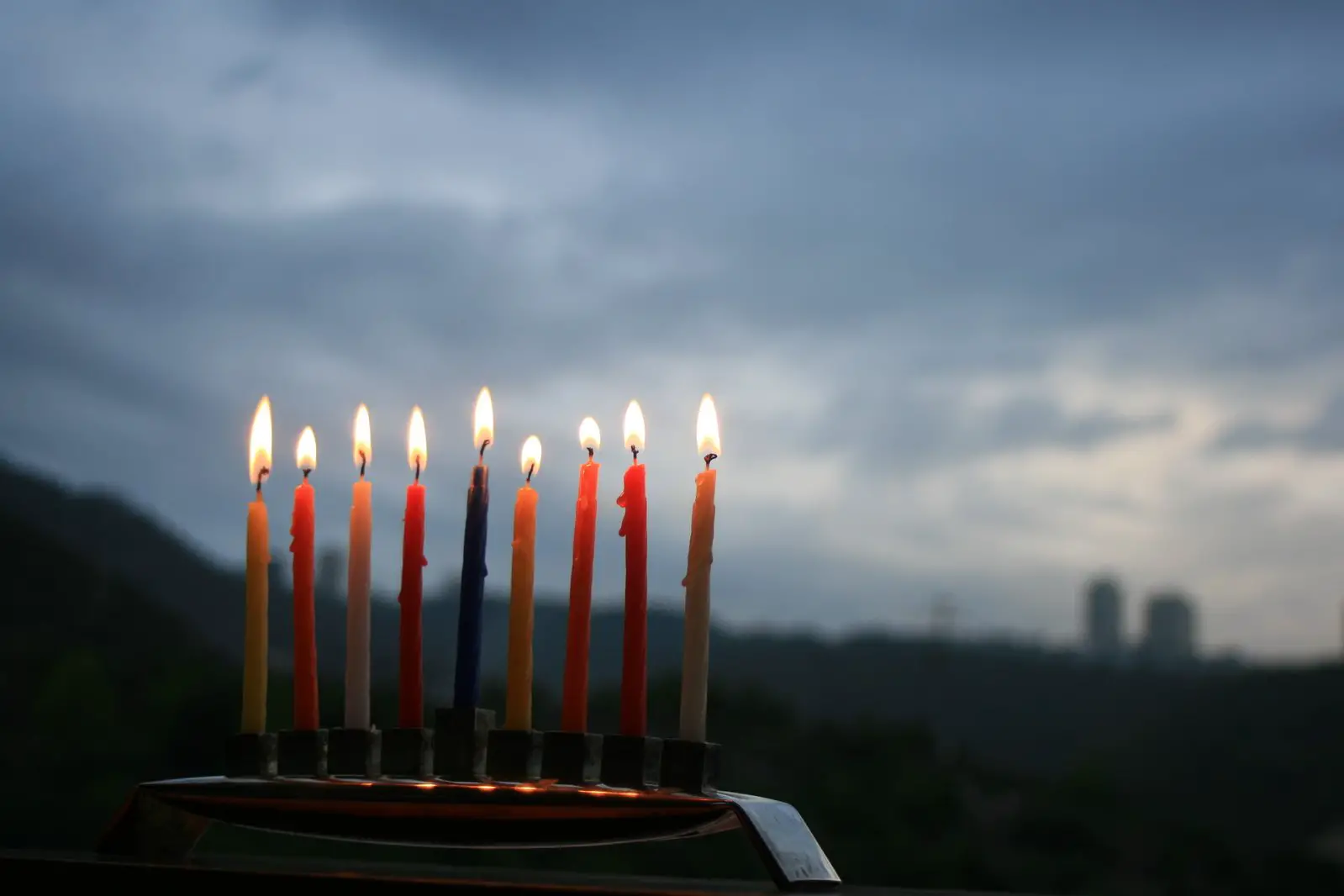Chanukah may fall out at the darkest time of the year. But, the very darkness gives the intense spiritual light Chanukah brings to the world the ability shine its brightest. This light is known as ohr haganuz, the hidden light of creation:
וַיֹּ֥אמֶר אֱלֹהִ֖ים יְהִי־א֑וֹר וַֽיְהִי־אֽוֹר
And God said, ‘Let there be light,’ and there was light.
Rashi: He saw it that it was not proper for the wicked to use it [the light]; so He separated it for the righteous in the future
With ohr haganuz, one can “see from one end of the world to the other,” (Chagigah 12a). What this means, according to the Sfas Emes (Chanukah 5661), is that in every “end” in creation– in other words, everything in the physical world which is by nature limited– there is a revelation of G-d and His Guiding Hand.
Even though G-d set aside the ohr haganuz during creation, this special light is still available to us in this world at certain times and places.
According to the Baal Shem Tov, the hidden light was concealed within the Torah itself. For this reason, it can be accessed by anyone who approaches Torah and mitzvos with proper intention. (Baal Shem Tov, Bereshis 32:1).
The ohr haganuz is also contained within the light of the Chanukah candles. Over the course of the eight days of Chanukah, we light a total of 36 candles. The candles parallel the number of times that the word “light” appears in the Torah. It is also equal to the 36 hours that the original light of Creation existed in the world before it was concealed in the Torah (See Bnei Yissaschar, Maamarei Chodshei Kislev-Teves 1-2).
An essential part of the mitzvah of lighting the candles on Chanukah is looking at them– specifically within the first 30 minutes after being lit since that is when the ohr haganuz shines out. This aspect of looking is not found with regard to any other mitzvah. According to the Nesivas Shalom, this is so our neshamos can be illuminated with the special hidden light.
In this hidden light is only unity, clarity, health, and peace. In this light we remember and connect with the Ribbono Shel Olam, its Source, and we are encouraged to see through the illusion of this world.
In that half an hour after we kindle the menorah, all the apparent separation, confusion, sickness and discord of this world takes on new meaning. It is the darkness itself that provides the setting and the space for the light to emerge. In fact, according to Rebbe Nachman of Breslov, there really is no darkness at all; there’s only hidden light.
It is this light of Chanukah that strengthens us and guides us to our personal geula, even as we sit in the darkness of exile. It calls out to us from the candles of the menorah: never stop searching for Hashem’s Presence in this world. Never stop thanking Him for all the goodness– all the goodness that surrounds us and all the goodness within us.
We don’t need to understand this light; it’s not something for us to “use.” But, each one of us has the ability to tap into it– that is, as long as we truly believe that we can.
The Nesivas Shalom states that Chanukah is a time for emuna and bitachon. These two qualities together are the very cli (vessel) that holds the hidden light of Chanukah.
The Difference Between Emuna and Bitachon
Though emuna and bitachon are connected, there is a key difference between the two qualities.
Emuna in G-d and His Torah is the first mitzvah of the Ten Commandments. It requires that one believe in the fundamental tenets about Hashem including that He is the Creator and Sustainer of the world and that there is Hashgacha Pratis, Divine Providence. It also requires that one believe in the Divine origin of both the written and oral Torah.
Bitachon, on the other hand, involves our personal relationship and connection to Hashem. According to Rabbeinu Bachya in his sefer Kad HaKemach:
G-d can transcend the laws of nature and change a person’s mazal (spiritual destiny). Although a situation may appear to be hopeless, Divine intervention can change that reality in an instant. G-d’s salvation is close at hand, for He is Omnipotent. Even if a sword rests on a person’s neck, he should not imagine that salvation is impossible… Thus said Chizkiyahu to Yeshaya the prophet: ‘I have received a tradition from my grandfather’s house, that even though a sharp sword rests on a person’s neck, he should not withhold himself from supplication to G-d.’
Elsewhere, Rabbeinu Bachya defines the quality of bitachon as:
The peace of mind of the one who trusts, that the one upon whom he relies [whether G-d or man] will do the best and the most appropriate for him in this matter… The main definition of trust is that one’s heart should believe that the one relied upon will fulfill what he has promised, and do good on his behalf, not out of obligation, but out of kindness
and mercy.
Chovos HaLevavos, Sha’ar HaBitachon, Chpt 1
Implicit in the above definition is the fact that even though we should never give up hope for a desired outcome or salvation, that desired outcome may in fact not be attained. Nevertheless, we accept that Hashem is doing everything out of His love for us and out of a knowledge of what is truly best for us. Even if we don’t understand why difficult things are happening, we remain committed and connected to Hashem. We also constantly strive to strengthen and encourage that connection so that we do not exchange our reliance on G-d for dependence on man.
According to the Nesivos Shalom, there are two levels of Bitachon. The first level of bitachon applies when we find ourselves in a difficult situation that is out of our hands. In this case, our goal is to trust that everything that happens will ultimately be for the good– whether or not the outcome is positive.
The second level of bitachon happens when we must choose to act in a way that demonstrates our trust in God. The Nesivos Shalom cites the example of Krias Yam Suf. In order for the Jewish people to merit the miracle of the splitting of the sea, and thus transcend the laws of nature, they themselves had to demonstrate a trust in G-d that transcended the laws of nature.
To pull everything together, while emuna is seeking out and connecting to Hashem’s light in the world and the way Hashem runs it, bitachon requires seeking out and connecting to Hashem’s light within ourselves. We are focused in on our personal connection to Hashem as it is expressed through our thoughts and actions.
Two Lights in the Darkness of Galus
During the period of Yetzias Mitzrayim (Egyption exile), the geula came to anyone who had even the slightest level of emuna. Chazal tell us that only one fifth of the Jewish people passed the test and thus merited to leave their Egyptian servitude:
וַֽחֲמֻשִׁ֛ים עָל֥וּ בְנֵֽי־יִשְׂרָאֵ֖ל מֵאֶ֥רֶץ מִצְרָֽיִם
…and the children of Israel were a fifth
when they went up out of Egypt.
Rashi: חִמֻשִׁים means “divided by five,” [meaning] that one out of
five (חִמִֹשָה) [Israelites] went out, and four fifths [lit., parts of the people]
died during the three days of darkness
Shemos 13:18
The salvation of the rabbinic festivals of Purim and Chanukah, however, depended on a deeper connection to Hashem– that is, both a deeper level of emuna and bitachon.
When Mordechai HaTzaddik declared a public fast in the name of Esther HaMalka, the Jewish people in Shushan had a choice to make. They could have succumbed to depression and hopelessness. After all, it really did seem like Hashem had abandoned His people and that they were on the verge of certain annihilation.
Instead, each and every Jew, young and old, chose to make a stand and declare, “This thing this depends on me!” They stood together, strengthened themselves in tefilla and teshuva, and cried out to Hashem for Divine mercy.
This outpouring of emuna and bitachon ushered in the miraculous events that followed.
Many years later, when the Chashmonaim (the main family of kohanim) entered the Beis HaMikdash after their miraculous victory over the Greek legions, they immediately got to work cleaning up and clearing the area of idols. They rebuilt the alter from scratch, created a make-shift menorah out of cheap metal, and rigorously searched for vials of pure olive oil with the special seal of the Kohan Gadol still intact. In the end, they only found one.
In a previous article, I explained that the real miracle of Chanukah was that the Chashmonaim so intensely yearned to light the menorah that it caused Hashem to create the situation of the oil lasting 8 days.
They strengthened themselves and immediately lit their insufficient portion of oil on their cheap makeshift menorah in the midst of the Beis HaMikdash that had been so defiled and that now stood empty of the Divine Presence. They choose to come closer to Hashem with the one vessel that still revealed His Presence even in the face of such difficult setbacks and obstacles.
It is important to note that the miraculous events of Chanukah came about through the kohanim, who are priests and not battle-hardened soldiers, and the word כֹהֵן (kohen) has the same gematria as the word בִּטָּחוֹן (bitachon) (Chesed L’Avraham, vol. 2, Moadim, L’Chanukah)
It’s also important to note that while the emuna of Pesach enabled the Jews to leave Egypt, the deeper level of emuna and bitachon experienced by the Jews during the events of Purim and Chanukah brought about a bigger redemption. Not only were we freed from the hands of our oppressors, in both cases we achieved dominion over them.
Realizing that the Jewish People would need chizuk in the bitter and lengthy exile following the destruction of the Beis HaMikdash, Chazal established Chanukah and Purim, each with their associated rabbinic mitzvos, as festive celebrations. Each year, these celebrations sustain us, shining the intense light of those original sparks of emuna and bitachon that the Jewish people brought down so many years ago.
So intense is this light that it will remain with us even after the coming of Moshiach, at which point the light of the other Yomim Tovim will become insignificant.
A Time to Strengthen Our Emuna and Bitachon
The eight days of Chanukah begin in the month of Kislev. The root of the word Kislev (כִּסלֵו) has references to both emunah and bitachon. “kesel, kisla” means the expectation and hope. It is also connected to the word “ksil,” or “fool” which hints to the fact that G d cares even for those who have acted foolishly (see Yismach Yisrael, Rosh Chodesh Kislev, 1-2).
The real miracle of Chanukah was internal, that the Jews were able to hold on, to step up to a battle that seemed lost before it began, and to serve Hashem even though that service may have seemed inadequate in so many ways. This took more than emuna. It required bitachon, trust not only in Hashem’s desire to give them good, but in their ability to receive it.
In closing, on Chanukah we have the opportunity and ability to tap into the ohr haganuz, the hidden light of hope and connection to the Ribbono Shel Olam. This light can not only illuminate our soul, it has the power to transform how we see Hashem and His world and ourselves within it. This knowledge in turn can transform all the separation and darkness in our lives into the connection and light it truly is.

